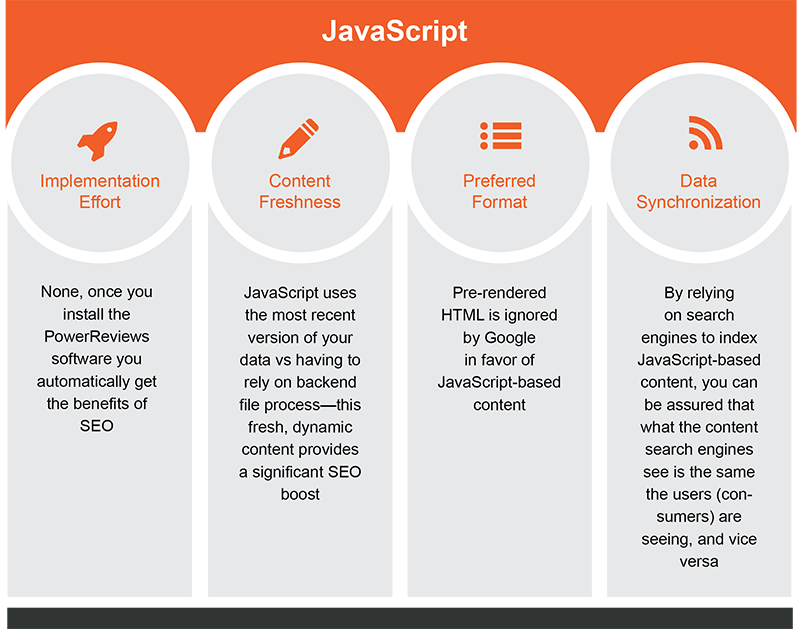Why PowerReviews’ Newest Best Practice is to Allow Search Engines to Index JavaScript-Based Content
Search engines will always be a necessary part for consumers to reach brands and retailers. The only certainty about search engine optimization (SEO), however, is change. Learn how PowerReviews arrived at their latest best practice of allowing search engines to index JavaScript-rendered content, and why this is beneficial to your business and your SEO team.
Embracing Search Engines’ Ability to Index JavaScript-Rendered Content
In recent years Google has gained the ability to render pages the way browsers do, and thus is now able to perceive webpages and content more as a human would (see “Help Google Understand Your Pages” on Google’s Webmaster Guidelines page). Because Google doesn’t publish the specifics of how they accomplish this, a significant amount of independent research has been done, and the results are consistent: Google indexes JavaScript-rendered content.
PowerReviews’ decision to update our standard recommendation regarding reviews and SEO was not made lightly. It was only after we evaluated thorough research with independent testing that we moved forward to better understand how to bring more value to our clients and their customers. To see for ourselves how pre-rendered HTML compares to JavaScript-rendered content, we conducted an independent study using real world data and controlled conditions. Just as the research we found discovered, we concluded that Google is indexing JavaScript-rendered content. More importantly, it can positively impact your SEO.
A Little Website History — From Multi-Page Applications (MPAs) to Single Page Applications (SPAs)
From the inception of the web until circa 2008, there was a single design pattern for architecting websites — Multi-Page Application (MPA) architecture. Using this type of architecture:
- The server generates a static page of content
- As the user interacts with the page, the server handles each interaction and gives the browser an entirely new page
By 2008, advancements in the web paved the way for a new website design pattern — Single Page Application architecture (SPA). Using this type of architecture:
- A browser loads a page containing JavaScript code
- JavaScript code runs on the web browser, rendering HTML (content) on the page
- As the user interacts with the site, JavaScript handles these interactions and re-renders the content that’s displayed
Some advantages of architecting a website as an SPA over an MPA include:
- A more fluid user experience
- Better performance
- Better scalability
- Faster development
Historically, search engines would index content by making a request to a URL and reading the HTML the server returned. As servers don’t handle rendering HTML in SPAs (browsers do), content in SPAs was essentially invisible to search engine bots.
How Pre-Rendered HTML Helped Procure SEO During the SPA’s Infancy
Due to their inherent advantages, SPAs quickly became prevalent across the internet. This change came quickly — faster than search engines could adapt. To fill this gap, the solution for allowing search engines to index content from SPAs was to:
- Run SPAs in a browser
- Save the HTML that the JavaScript rendered
- Provide that markup to be served to search engines
Pre-rendered HTML, while solving some problems, is not without fault. Its use can bring about the following issues:
- Because the process of pre-rendering HTML happens periodically (maybe once every 24-48 hours), the content and data in pre-rendered HTML can be stale – which will negatively impact SEO. Frequent updates and fresh content leads to higher search ranking and encourages search engines to index sites more frequently.
- Scalability is an issue — as the size of a site grows, the more HTML there is to pre-render. The longer this process takes, the less fresh the pre-rendered content is. For example, if a new piece of data or information was added globally across a site, a significant number of pages would have to be re-rendered.
- A wide range of new variables would be added into the development process, requiring ongoing maintenance and further investment — and could slow down innovation.
A PowerReviews Independent Study
In addition to determining that Google does, in fact, render JavaScript content, we also found:
- When using both pre-rendered (HTML) content and JavaScript-rendered content on the same page, the JavaScript-rendered content was indexed by Google while the HTML content was ignored
- Structured data (additional SEO data that can be provided to search engines to create more paths to connect consumers with your content, called Rich Snippets) was perceived and used by Google when rendered via JavaScript
Why develop pre-rendered HTML? It’s simply a way to have JavaScript-rendered content indexed by search engines that can’t render JavaScript – which, at the moment, is everyone but Google. But the fact that Google can crawl JavaScript-rendered content means that it has more content within its index than search engines that cannot crawl these types of sites.
Google, with a commanding share of the search engine market, has a significant competitive advantage. While #2 search engine Bing does not yet have this capability, this competitive disadvantage along with the increased prevalence of dynamic, Javascript-rendered content will force search engines to build this capability.
The Takeaway: Why Indexed JavaScript-Rendered Content is Preferred Over Pre-Rendered HTML
As the functional capabilities of pre-rendered HTML and JavaScript-based content are equal (where supported), here are the highlights of JavaScript-rendered content advantages:

Higher search ranking. More visibility in search engine results. Further reach to consumers. Clearly, SEO through indexing of JavaScript-based content is superior to using pre-rendered HTML. As such, this is the position and approach PowerReviews will have for our clients on content and SEO moving forward, until the next change in SEO.
If you would like to learn more about using leading edge SEO to improve your brand’s or retailer’s reach, request a demo or contact us with your questions and one of our experts will get back to you.



